


 Biography: David Montross Gazlay
Biography: David Montross Gazlay
By Lee Gazlay and Adine Wakefield
T
hree people have been identified in historical records with the name David Montross Gazlay. The eldest David Montross Gazlay, the son of Aaron Gazlay and his wife Abigail Sutton, was born 12 February 1798 in Dutchess County, New York, and died 3 May 1877 in Pomfret, Windham County, Connecticut. He was a school teacher and lived in New York, Kentucky, and Connecticut. Next was David Montross Gazlay, the subject of this biographical sketch, who was born in 1835 and died in 1895. He was a nephew of David the teacher, and was publisher and editor of business directories, newspapers and periodicals, and engaged in other business ventures. This David had a son, the third David Montross Gazlay, who died in 1876, aged seven years.
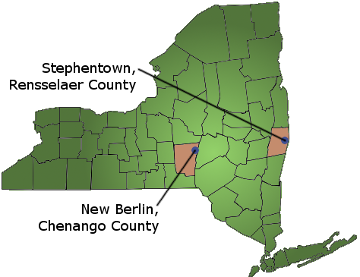
David M. Gazlay is first found in the 1850 US Census as a 13 year old boy living in New Berlin, Chenango County, New York, with another child, Mary C. Gazlay, eight years old, and two adults, Charles Gazlay, aged 35 years, and Abigail Gazlay, aged 68 years. This Abigail Gazlay is undoubtedly the mother of David M. Gazlay the teacher, and his Last Will and Testament names a brother Charles M. Gazlay, presumed to be the same Charles in this 1850 census record.
Her full name, from other records, is Mary Cornelia Gazlay, and the 1855 New York State Census lists her as Cornelia Gazlay, aged 14 years, along with the same Charles M. Gazlay, aged 39 years, his then-wife Catherine, aged 22 years, and a child Henry Gazlay, aged three years, all living in New Berlin.
A notable detail in the 1855 New York State Census is that the birth county is given for people born in New York State. For this Gazlay family, the census lists Chenango County as the birth place for Charles, Catherine and Henry, while Cornelia’s birthplace is listed as Rensselaer County. Charles, Catherine, Henry, and an additional child, Charlie M., are found in the 1860 US Federal Census, living in New Berlin. The 1865 New York State Census lists Charles, his wife Catherine, sons Henry and Charlie M., and a new daughter, Georgiana, still living in New Berlin. This census record lists Charles M. Gazlay as having been married two times, an important detail. Also, Catherine is listed as having been married only once, and the parent of three children (apparently, Henry, Charlie M., and Georgiana).
Various records place Mary Cornelia Gazlay (with married surnames Avery and Flower) in Rensselaer County in later years, and provide a name for her mother, Martha Ann, who, as a widow, married a widower named Abraham/Abram Coons, who had recently returned to his native Rensselaer County. Both Martha and daughter Mary Cornelia died in Rensselaer County, as indicated in probate records.

The fact that Mary Cornelia and Martha Ann were living in Rensselaer County when David Montross Gazlay died in 1895, and the presumption that David was born in Rensselaer County, likely explains why he was buried in Hillside Cemetery, Stephentown, Rensselaer County. Relatives of Martha’s last husband, Abraham Coons, are also buried in Hillside Cemetery, although Abraham and Martha’s burial places have not been determined (nor has Mary Cornelia’s).
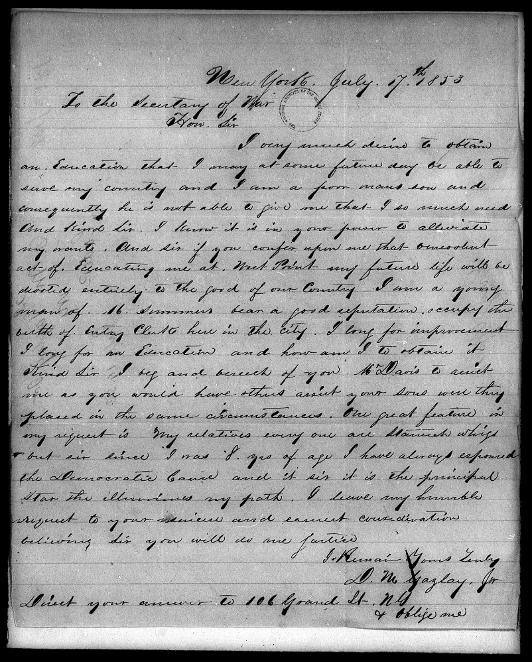
New York, July 17th 1853
To the Secretary of War
Hon. Sir,
I very much desire to obtain an education that I may at some future day be able to serve my country and I am a poor man’s son and consequently he is not able to give me that I so much need and kind sir I know it is in your power to alleviate my wants. And sir if you confer upon me that benevolent act of educating me at West Point my future life will be devoted entirely to the good of our country. I am a young man of 16 summers, bear a good reputation, occupy the berth of Entry Clerk here in the City. I long for improvement. I long for an education and how am I to obtain it. Kind sir I beg and beseech of you Mr. Davis to assist me as you would have others assist your sons were they placed in the same circumstances. One great feature in my request is my relatives, every one of them are staunch Whigs but sir since I was 8 yrs of age I have always espoused the Democratic cause and it is the principal star the [sic, that] illumines my path. I leave my humble request to your sincere and earnest coordination believing sir you will do me justice.
I remain yours truly,
D. M. Gazlay, Jr.
Direct your answer to 106 Grand St. NY + Oblige me
David apparently received a reply to his first letter, and he answered it with the following:
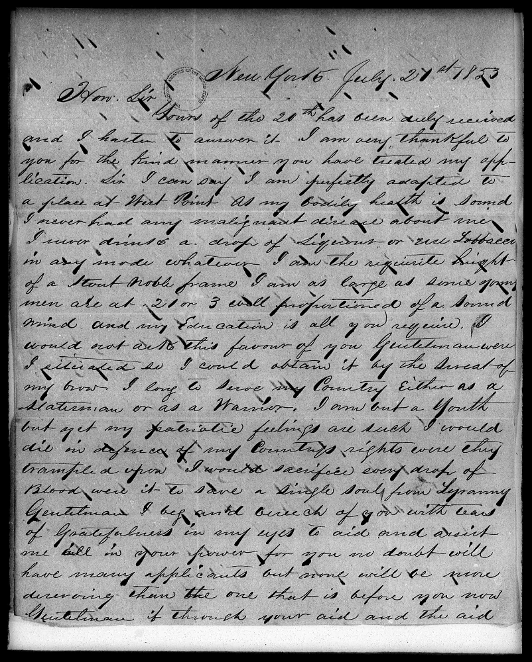
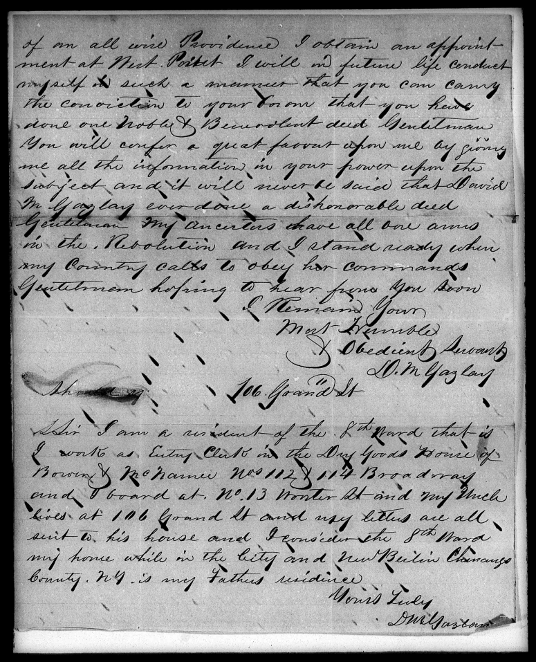
New York, July 21st 1853
Hon. Sir,
Yours of the 20th has been duly received and I hasten to answer it. I am very thankful to you for the kind manner you have treated my application. Sir I can say I am perfectly adapted to a place at West Point as my bodily health is sound. I never had any malignant disease about me. I never drink a drop of liquor or use tobacco in any mode whatever. I am the requisite height of a stout noble frame. I am as large as some young men are at 21 or 3, well proportioned of a sound mind and my education is all you require. I would not ask this favour of you gentelmen were I situated so I could obtain it by the sweat of my brow. I long to serve my country either as a statesman or as a warrior. I am but a youth but yet my patriotic feelings are such I would die in defence of my country’s rights were they trampled upon. I would sacrifice every drop of blood were it to save a single soul from tyranny. Gentelman I beg and beseech of you with tears of gratefulness in my eyes to aid and assist me all in your favor for you no doubt will have many applicants but none will be more deserving than the one that is before you now. Gentelman if through your aid and the aid of an all wise Providence I obtain an appointment at West Point I will in future life conduct myself in such a manner that you can carry the conviction to your favor that you have done one noble & benevolent deed. Gentelman you will confer a great favour upon me by giving me all the information in your power upon the subject and it will never be said that David M. Gazlay ever done a dishonorable deed. Gentelman my ancestors have all bore arms in the Revolution and I stand ready when my country calls to obey her commands. Gentelmen hoping to hear from you soon.
I remain your most humble obedient servant,
D. M. Gazlay
106 Grand St.
Sir I am a resident of the 8th Ward that is I work as Entry Clerk in the Dry Goods House of Bowan & McNamee Nos. 112 & 114 Broadway and I board at No. 13 Worster St. and my uncle lives at 106 Grand St. and my letters are all sent to his house and I consider the 8th Ward my home while in the City and New Berlin Chenango County, NY, is my father’s residence.
Yours truly,
D. M. Gazlay
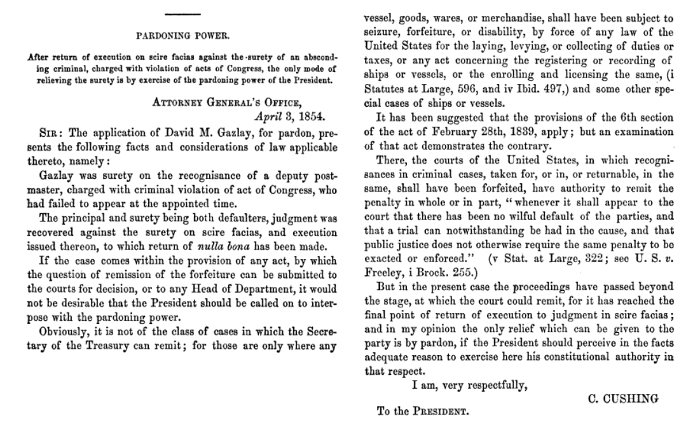
Edited by C. C. Andrews. Washington: Published by Robert Farnham, 1856.
The exact circumstances that led up to this request for pardon are not clear, but apparently there was some sort of legal action taken against David, who would then have been about 18 years old. A document in a Sotherby’s auction provides the amazing resolution to this matter. Lot 127 auctioned on 4 June 2013 contains an extensive collection of autographs of the Presidents of the United States. Among the documents is one described as follows:

The newspaper itself endorsed David’s business venture in a separate advertisement.
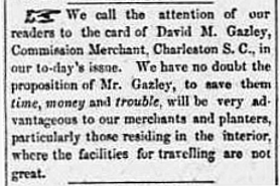
David advertised for merchandise as far away as Massachusetts, as indicated in the following transcription from the Daily Atlas, Massachusetts, 20 July 1855 (and several other issues of the same newspaper):
General Produce and Commission Merchant
David’s first known publishing venture occurred in Charleston. James William Hagy, in his Directories for the City of Charleston, South Carolina: For the Years 1849, 1852, and 1855 (Genealogical Publishing Co., Baltimore, 1998), describes David M. Gazlay’s 1855 Charleston City Directory as follows:
David M. Gazlay, who lists himself as a general commission agent, published The Charleston City Directory and General Business Directory for 1855: Containing the Names of the Inhabitants, Their Occupations, Places of Business and Dwelling Houses: A Business Directory; A List of the Streets, Lanes, Alleys, the City Offices, Public Institutions, Banks, &c. (Charleston: David M. Gazlay, 1855). In the Preface he states that he is “aware that in it exists many mistakes and imperfections, which are principally confined to the Upper Wards.” He says, “I met with a great many obstacles. . . the most prominent of which was the defect in regard to the houses not being numbered, and in many cases if numbered, not properly done, in the Upper Wards.” He promised he would issue thereafter a directory “annually, corrected and revised.” Other cities, he indicated had annual directories -- “why need Charleston be so far behind the age?” This however, is the only one he published. It has 5,368 entries. The volume has a number of interesting advertisements, some with drawings.
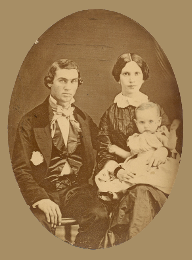
Exactly when and where David met his first wife, Anna Sophia Masterton, is not clear, but one would expect they must have known each other for some reasonable period before their marriage on 4 November 1858 in New York City and his departure for California the next day. Anna was a widow when she married David. Her maiden name has not been determined. Her first husband, David Masterton, died tragically on 25 July 1855 in South Bergen, Jersey City, Hudson County, New Jersey, while he was showing Anna a firearm that accidentally discharged, killing him almost instantly. David Masterton left his widow Anna and two young daughters, Martha Washington Masterton, and Ella Isabella Masterton. David Gazlay is said to have adopted the two daughters.
A David M. Gazlay, presumed to be the same as the subject of this biographical sketch, is named in New York Deaths and Burials, 1795-1952, as the father of a female who was born on 10 February 1857 in New York City, died the same day, and was buried in New Jersey. Curiously, the mother of the child is not named. Why was the child buried in New Jersey? Since Anna Masterton had lived in New Jersey when her first husband died, it seems possible that she may have been the mother of David M. Gazlay’s infant daughter, but was not named in the death record since she was not married at the time.
This section is based almost entirely on a fascinating essay about David Montross Gazlay written by Adine Wakefield in 2001. Adine is a direct descendant of David’s first wife, Anna Sophia Masterton, through her eldest daughter Martha Washington Masterton by Anna’s first husband David Masterton. Edited and illustrated by Lee Gazlay.
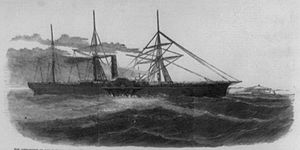 The ill-fated SS Central America, sister ship
The ill-fated SS Central America, sister shipof the SS Illinois, operated by the
U.S. Mail Steamship Company.
When the Sidewheel Steamship Illinois advertised that it was sailing from New York City on Friday, 4 November 1858, with passengers and mails directly to Aspinwall, (now called Colón), Panama, David decided it was time to try his fate and fortune under the “canopy of a California sky.”
Having said good bye to his 24 year old wife of one day (he married widow Anna Sophia Masterton at Allen Street Methodist Church, N.Y. City, 4 November 1858) and his two adopted little step-daughters, Martha (Martha Masterton, born July 3, 1853) and Ella (Ella Masterton, born October 28, 1854), David boarded the SS Illinois at lower Manhattan’s South Street, then known to the world as the “Street of Ships.” Stormy weather detained the ship’s departure. The delay may have been due to an abundance of caution, with the sinking of Illinois’ sister ship SS Central America still fresh in people’s minds. The Central America sank on 3 September 1857 off the North Carolina Coast, with a loss of 425 lives and up to 21 tons of gold. The wreck was discovered in 1987 and much of the gold was recovered, although the fate of much of the recovered gold is still the subject of controversy and legal challenges.
While waiting on board, David noted that there were three different classes of passengers, each occupying a specific place on the ship. The passengers who paid the least amount of money were provided stationary hammocks filled with straw mattresses and pillows; food consisted of horse meat, mush, molasses, little butter and no milk, all served on tin plates. The passengers who paid a greater amount of money were provided berths; good and wholesome food was served on specially designed tables just for them. The passengers who paid the most received all the luxuries of a first-class hotel—with the exception of ice on the Pacific side, which anyone could purchase at 25 cents per pound.
When the stormy weather gave way to blue skies on Sunday morning, November 7th, SS Illinois raised anchor and began her voyage. With three hearty cheers from its passengers, it rounded and headed down the bay, passing Governors, Staten and Coney Islands. The blue hills of New Jersey were soon lost in the distance with nothing but deep blue ocean beneath and bright blue heaven above.
David was impressed with the steamship’s attentive and skillful navigator, Captain John McGowan. The captain would not allow the playing of checkerboard on Sundays—no gaming on board on the Sabbath. And when one of the cooks became over-heated and died, Captain McGowan saw to it that the man was sewn up in a sack, weights attached, wheels of the steamer stopped, a brief prayer with few appropriate remarks made, and the remains launched into the ocean.
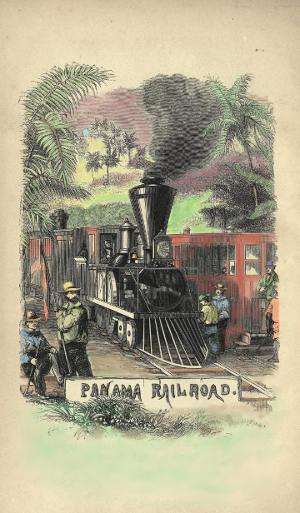 Panama Railroad. From the Illustrated History of the Panama Railroad,
by F. N. Otis, M.D. Second Edition, Revised and Enlarged. New York:
Harper & Brothers, Publishers, Franklin Square. 1862. Available at Google Books. Color tinted by Lee Gazlay.
Panama Railroad. From the Illustrated History of the Panama Railroad,
by F. N. Otis, M.D. Second Edition, Revised and Enlarged. New York:
Harper & Brothers, Publishers, Franklin Square. 1862. Available at Google Books. Color tinted by Lee Gazlay.The SS Illinois soon passed in sight of the islands of Cuba, St. Domingo, and St. Thomas. On the ninth day of the voyage, she arrived at the port of Aspinwall (now called Colón), Panama. While the steamship anchored next to an American sloop-of-war vessel, David and rest of the passengers heard its band playing “Hail Columbia.” Everyone on board spontaneously responded with a “three times three for Uncle Sam.” Never in his whole life had David been so proud of his nationality.
The second phase of the journey involved a train ride from Aspinwall (named for New Yorker William Aspinwall who helped finance the Panama Railroad) to Panama City, a total distance of 49 miles (five years to build: 1850-1855, and 49 years before the Panama Canal was completed). The train trip, however, was delayed for a few days due to broken bridges from high waters in the Chagres River. This unexpected delay in Aspinwall was not enjoyed. Sleeping accommodations and decent meals were scarce. Low marshy land gave way to chills and fevers. Local liquor and fruit were forbidden. The only relief that could be found during the stay at Aspinwall was listening to the beautiful music being played by the sailors and marines who were ashore from their vessels of war.
When news came that the bridges were open, David boarded the Panama Railroad train and began his journey to Panama City. While traveling across the Isthmus of Panama, he noticed that the road was well constructed and the rails were laid well. Its countryside was picturesque and wild-appearing. The summit (Culebra) was reached within hours of traveling. The train would then stop and local natives would sell their fruit. Remainder of the train trip was a gradual slope to the Pacific.
David saw Panama City as a place of considerable importance. The city was walled in, and was said to be three hundred years old. Adobe houses rather than thatched huts were present everywhere.
Steamship John L. Stephens (named after one of the financiers for the Panama Railroad Company) was now ready to be boarded. She was a large steamship and was anchored three miles out at the Island of Taboga. A small steamer transported the passengers out to it. SS John L. Stephens was one of the best steamers available of its time. She possessed a most beautiful deck promenade. She was a wooden side wheeled steamer with three decks, two masts, two stacks and a Pierson’s Patent Steam Condenser that supplied fresh water to its boilers. Two hundred fifty berths were on the upper deck and 550 single berths were on the lower deck. The Stephens carried eight large lifeboats. She was owned by the Pacific Mail Steamship Company.
Twenty-four hours out from Panama, SS John L. Stephens passed the SS Sonora that was heading toward San Francisco. Nothing of interest occurred on the trip up to Acapulco, except large schools of porpoises and occasionally a whale could be seen. The Mexican Coast was in sight all the way up. Six days sail brought the SS John L. Stephens to the Mexican port of Acapulco, a remarkable harbor situated on a small inlet almost entirely surrounded by high bluff land. The Mexican Government had a fort there, occupying a commanding position to the harbor. While the steamer took on coal and cattle, the passengers were taken ashore by natives for the price of $.50/person. Acapulco, like all Mexican towns, wore an old and antique appearance, bearing strong evidence of a nation once powerful. The native senoritas were models of female beauty. The Catholic Church already was a couple hundred years old. The stay at Acapulco was very short.
One and a half days sail from Acapulco brought David to the Mexican port of Manzanillo. There, the steamer took on coined money. The arrival was at nighttime and the stay was short.
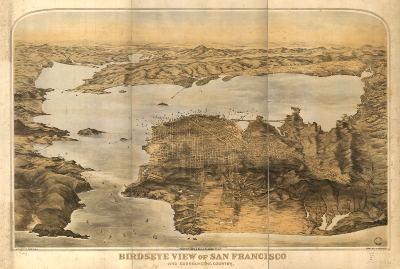 Birds Eye View of San Francisco. Created and published by
Birds Eye View of San Francisco. Created and published by Snow & May, c.1876. Library of Congress map collection.
Six days of more sailing and in the face of a most terrific head wind and rough sea, David had his first glimpse of the Golden Gate. His first impressions were rather unfavorable. He saw hills that were broken and irregular in appearance and other things that were unusual to the great and older cities of the East. The SS John L. Stephens passed between Alcatraz Island and Telegraph Hill; anchoring at Folsom Street Wharf. David noticed that the wharves were connected to the ends of the streets and were named after them: Washington Street Wharf, Jackson Street Wharf, Pacific Street Wharf, Broadway Wharf, Clay Street Wharf, California Street Wharf, Market Street Wharf, etc. Owners of the wharves demanded huge tolls from the passengers, vessels, and cargo. Some wharves were small cities of stores and shops. Looking back, David’s voyage from New York to San Francisco lasted about 27 days (arrival was approximately on 3 December 1858).
David’s first impressions of San Francisco quickly changed when he walked its streets. He saw well-built buildings and facilities that provided lighting and water, educational and religious buildings, manufacturers, marks of wealth and enterprise with prosperity visible everywhere. In the short space of eleven years, San Francisco had arisen to a great and populous city, representing millions in wealth, and boasting of eighty thousand people.
Three and a half months later on 17 March 1859, David’s wife Anna Sophia, with 40 year old companion Miss M. Sniper and Anna’s two little daughters, Martha and Ella, arrived in San Francisco on a subsequent voyage of the SS J. L. Stephens. Mrs. Gazlay introduced Reverend John Calvin Holbrook to David. Reverend Holbrook (born 7 January 1808), his wife Anne Clark Holbrook (born 9 December 1822), and Mrs. Gazlay met during their voyage from New York to San Francisco and had developed a strong friendship. Reverend John C. Holbrook was acting minister for San Francisco’s First Congregational Church (during the year 1859) while its regular minister, Edward S. Lacy (1856-1865), was taking leave of absence due to illness.
The Gazlay household was located in the central and respectable part of San Francisco, at 249 Washington Street near the corner of Stockton Street. They were members of the First Congregational Church (located at California and Dupont Streets; Dupont Street being Grant Street today) where the Reverend John C. Holbrook was minister. Mrs. Gazlay was pregnant. She also had her own business at home: a female employment office, the only office in San Francisco exclusively for females. David was working on his mercantile journal which was soon to be published. Life for the Gazlay family, however, was quickly interrupted: Mrs. Gazlay died after giving birth to her premature baby daughter, Anna Sophia Gazlay, born 1 1/2 months too early. Mrs. Gazlay’s death on Thursday, 27 October 27 1859 at age 24 years was followed by her funeral on Saturday, 29 October. Reverend John C. Holbrook performed the funeral services for Mrs. Gazlay—the woman with whom he and his wife (Anne Clark Holbrook) had become dear friends 7 1/2 months earlier while travelling from New York to San Francisco. Burial for Mrs. Gazlay was at Laurel Hill Cemetery, a beautiful park-like cemetery located just south of the Presidio (ninety seven years later, her remains were removed from Laurel Hill Cemetery and reburied at Cypress Lawn in Colma City, ten miles south of San Francisco. A new law required that all remains within the city be removed, except those in the historic plot at Mission Dolores and at the Presidio). The following day, on Sunday, 30 October, Reverend Holbrook gave his last sermon at the First Congregational Church. He and his wife Anne returned to New York. [Anna Sophia’s birth surname has not been ascertained. Her death notice in the Sacramento Daily Union indicates she was the “grand daughter of the late General Hitchcock, of London, Eng.” The identity of this General Hitchcock has also not been determined.]
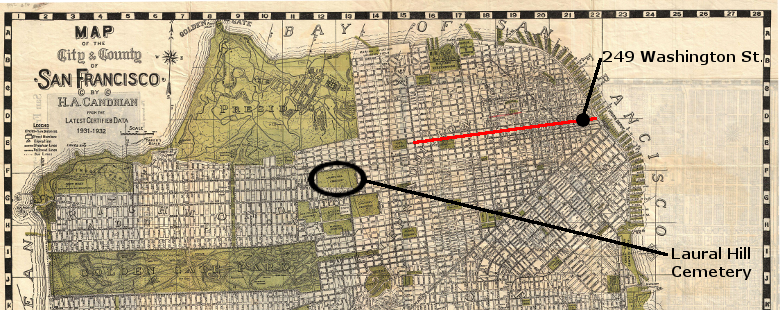 Map of the City & County of San Francisco (portion), by H. A. Candrian, 1931-1932. Library of Congress map collection.
Map of the City & County of San Francisco (portion), by H. A. Candrian, 1931-1932. Library of Congress map collection.David was now left with two little girls (ages six and five) and a newborn baby daughter (named Anna Sophia). When the baby died 11 days old on Monday, 7 November 1859; (death notice in the Daily Evening Bulletin on Tuesday, 8 November 1859; burial on 8 November), David decided it was best if the two little girls (still under the name of Gazlay) and their 40 year old companion, Miss Snipe, who had traveled with them 7 1/2 months earlier, return to New York. They arrived at New York City on 24 December 1859 via the Steamship Baltic. Reverend John C. Holbrook and his wife Anne, having taken a fancy to the girls during their voyage to San Francisco, were permitted to adopt them.
David remained in San Francisco. He had a dream. He wanted to publish a good, cheap, and desirable mercantile journal for both Europe and the States. He wanted it to contain business cards of well-known commercial, mercantile, and manufacturing businesses of the world. He wanted it to have useful information such as departure times for steamers (Mail Company: Golden Gate, Golden Age, John L. Stephens, Sonora), editorials, illustrations, and yearly statistics such as the number of people who arrived and departed by steamers. He wanted it to be distributed to the most populated areas in the country and without charge.
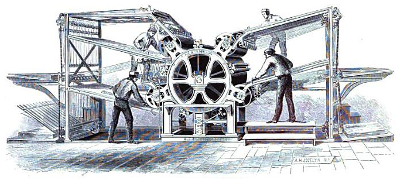
A Short History of the Printing Press, Printed and Published
for Robert Hoe. New York, 1902. Available at Google Books.
In 1860, David’s dream came true: his California Mercantile Journal for 1860 was published (Charles F. Robbins, Printer, 111 Clay Street). It was distributed throughout California and Oregon. Hotels, steamboats, steamships, libraries and reading rooms received it. San Francisco merchants supported the Journal by having their business cards printed in it.
The Journal was fairly successful. Publishing, however, was not easy. San Francisco was only 11 years old. More appropriate reading material, better illustrations and heavier paper were needed. Additional canvassing for advertisements was also necessary. David concentrated on these improvements. He thought of Sacramento, the city of the plains and capital of the State. When he visited and solicited his mercantile neighbors of Sacramento, he discovered that they had a jealous spirit of rivalry so great toward anything or anybody emanating from San Francisco that all thoughts of a possible Sacramento department were abandoned.
David remained optimistic. He wanted his next publication to have an advertising medium that was respectable, popular, permanent, general and cheap. At the same time, it was to contribute to the literature of California. It was to be interesting, useful and ornamental. It was to be published yearly.
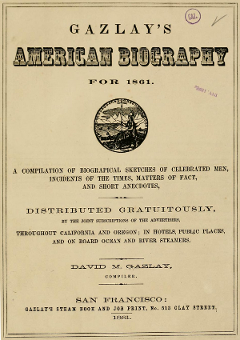 Gazlay’s American Biography for 1861.
Gazlay’s American Biography for 1861.Available at Google Books.
In 1861, David printed not only his second, but his third and fourth publications. [Adine Wakefield’s numbering of David’s publications (second, third, etc.) reflects that she was unaware of his earlier Charleston directory or a few later publications when she wrote this essay.] The second publication was titled Gazlay’s American Biography For 1861. It carried out the new system of advertising that David had started the year before in the California Mercantile Journal (advertisements of California firms were interspersed and paged with the text). It included illustrations of California life and national biographies. It was distributed throughout California and Oregon by means of hotels, public places and on board ocean and river steamers.
David’s third publication was titled Gazlay’s San Francisco Business Directory for 1861. It supplied something that San Francisco had lacked: a compact, reliable and cheap business guide that would be useful to the country, city, merchant, tradesman, and professional.
His fourth publication was quite different from the others: it was titled Union Songster Containing A Choice Selection of National and Patriotic Melodies. The Civil War had just begun that year, on 12 April 1861.
Two years later, David’s fifth publication titled Gazlay’s San Francisco Business Directory For 1863 was printed. It was laid out beautifully...the trades and professions were classified and arranged under appropriate headings in alphabetical order.
David now had been in San Francisco for six years. He decided it was time to go home...home to New York and New York City...which he did.
His next publication was printed in New York. It was titled Gazlay’s Business Directory of the Five Great Cities of California and Oregon 1864, 1865...the great cities being San Francisco, Sacramento, Stockton, Marysville and Portland, Oregon. Ads for the Directory were provided from the East and the West.
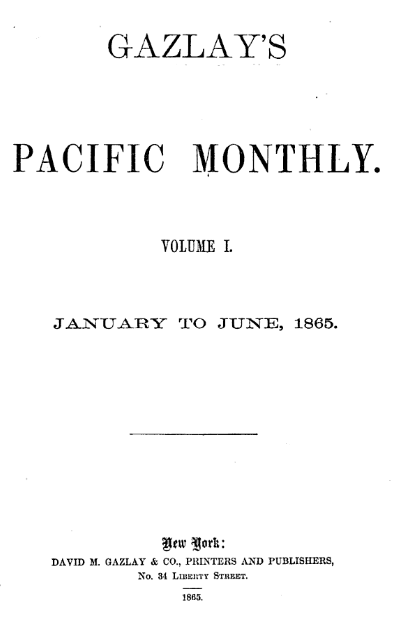
Available at Google Books.
David saw that California was sadly misunderstood and grossly misrepresented on the Atlantic side. He decided to publish a magazine in defense of California interests. He titled it Gazlay’s Pacific Monthly (David M. Gazlay & Co. Printers and Publisher, No 34 Liberty St. N.Y. 1865). He cut his expenses in half by having it published in New York rather than San Francisco, sending it out by steamer to his agents for distribution. It was a magazine priced reasonably and published monthly. It lasted, however, only seven months (January 1865 through July 1865).
A description of the Pacific Monthly appears in The Overland Monthly, The Overland Monthly Company, San Francisco., 1888. Vol XII — Second Series, July-December 1888. October, 1888 — No. 70, Page 342:
David’s eighth and last publication occurred ten years later. It was a cute little book about the size of a 3x5 card titled Gazlay’s United States Hotel Guide for 1875. David had felt that a cheap and convenient Pocket Reference Book for the use of travelers, hotel men and the public was greatly needed (this little pocket booklet was published by the Franklin Publishing Company, 67 Liberty Street, New York City, D. M. Gazlay, President; W. M. Kearney, Secretary).
The two little girls that David gave up for adoption eighteen years earlier in San Francisco, were now respectable young women. One of them, Martha, met and married Edwin B. Noble (1872) while her adopted father, Reverend John C. Holbrook, was pastor at the Stockton Congregational Church (1870-1873; Stockton, California).
Reverend John C. Holbrook retired in 1881 at the age of 73; he had completed nine years as the First Secretary of the New York State Home Missionary Society in Syracuse, New York. He and his wife Anne returned to Stockton and lived the remaining years of their lives with their adopted daughter Martha and her husband Edwin B. Noble.
An article in the Nelson Examiner and New Zealand Chronicle [yes, New Zealand!], Volume XVIII, Issue 54, published on 6 July 1859, indicates that David had associations with newspapers in New York and Charleston before coming to California:
The Hamburg Ship Tusco has brought to Melbourne California news to the 13th March. From the Era’s: summary of city events for the week ending the 13th, we take the following:—
“The unbridled license so long enjoyed by the press of this city is in danger of being checked. In the case of David Jobson v. W. H. Newell, et al., of the Daily Times, for defamation of character, the jury have rendered a verdict against defendants for 1,000 dollars damages. One David M. Gazlay has also commenced an action in the Twelfth District Court against C. A. Washburn, Alvin J. Flanders, William V. Wells, and Henry Johnson, the new publishers and proprietors of the same paper, to recover 10,000 dollars damages. The cause of action is a statement which appeared in the Daily Times of 4th March, entitled ‘Another Imposter,’ which charged plaintiff with being a bummer and a thief, and that his representations to the effect that he had been connected with the New York Herald and Charleston Mercury were false.”
The resolution of the action is not known.
The San Francisco Directory for the year commencing June, 1859 (compiled by Henry G. Langley), lists David as a clerk at 11 Clay Street, along with a Daniel Gazlay, also a clerk at the same address. The identity of this Daniel has not been determined. David M. Gazlay was listed the previous year in Trow’s New York City Directory of 1859 (for the year ending 1 May 1859), working in an eating house on 480 Broome St.
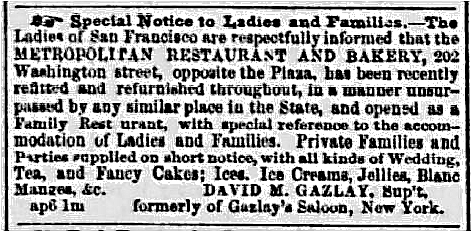
David, along with one M. L. Ingles, operated the Metropolitan Restaurant and Bakery at 202 Washington St., San Francisco, in early 1860. On 10 April 1860, the explosion of a small boiler destroyed part of the restaurant, but fortunately no one was injured. They quickly refurbished the restaurant and reopened for business, as indicated in an advertisement in the Daily Alta, San Francisco, on 24 April 1860 (and other issues). Note the reference to David’s former business, Gazlay’s Saloon, New York, which is probably the “eating house” identified in the New York City Directory of 1859.
The San Francisco Directory for the year commencing July 1860 has two listings for David: Gazlay, David M. (Ingles & G.) dwl [dwelling] El Dorado Bdg.; and Ingles (M.L.) & Gazlay (David M.) Metropolitan Restaurant, 202 Washington.
Several newspaper articles in 1860-61 show that David was a Union loyalist and participated in pro-Union activities in San Francisco.
David C. Broderick was an abolitionist Democrat who was a member of the California State Senate from 1850 to 1851. From then, he exerted nearly absolute control of San Francisco in the same way that Tammany controlled New York. Broderick was elected as a Democrat to the United States Senate, serving there starting on 4 March 1857. A protracted and escalating dispute with his once-friend David S. Terry, pro-slavery advocate and former Chief Justice of the California State Supreme Court, resulted in a pistol duel on 13 September 1859, in which Broderick was fatally wounded. He died three days later. The public viewed Broderick as a martyr, and in time a monument was planned for his grave in Lone Mountain Cemetery in San Francisco (the cornerstone for the monument was laid on 22 February 1863). David played a part in raising funds for the monument, as indicated in a 17 January 1861 article in the Daily Alta California newspaper.
The Daily Alta California published a lengthy article in the 21 February 1861 issue, titled “Preliminary Union Meeting. Preparatory to the Grand Union Demonstration, to be Held on Washington’s Birthday.” The meeting included citizens irrespective of party. The purpose of the meeting was to “to take the preliminary steps to call a meeting of the citizens of San Francisco, to express their sentiments on the question of the union or disunion of these United States.” From the speeches published in the article, it is clear that this was a strongly pro-Union gathering, just a few weeks after seven southern states had declared their secession from the Union, on 4 February 1861, and on the brink of the Civil War. David was present at this preliminary meeting, and the article indicates that “Mr. D. M. Gazlay moved that a Committee of Thirteen be appointed to make preparation for the proposed meeting, and supported the motion with a few remarks.” The motion was amended by Mr. Horace Hawes that the number was too large, and moved as an amendment that a Committee of Five be appointed to make the preparations, and a Committee of Seven to draft resolutions. After a few more remarks, the amendments were adopted, and two Committees were appointed: Committee of Management, which included D. M. Gazlay as a member, and a Committee on Resolutions.
The meeting was held on 22 February 1861 as planned. According to the Proceedings of the Great Mass Meeting, in Favor of the Union, Held in The City of San Francisco, on Washington’s Birthday, February 22d, 1861 (San Francisco: Printed at the Alta California Job Office, 124 Sacramento Street, 1861), the location was the junction of Market, Montgomery, and Post Streets. The venue was lined with banners of patriotic slogans, and American Flags everywhere. A crowd of “at least fourteen thousand persons were congregated, full of unalterable love and enthusiasm for the Union, and eager to pledge California to the galaxy of Union-loving States.”
On 7 May 1861, the Douglas Democratic State Central Committee, another pro-Union organization, met in Sacramento. A long article in the Sacramento Daily Union on 11 May 1861 indicates that after roll call and resolution of a point of order, the “Chairman read to the Committee a communication relative to the establishing a party organ in San Francisco, addressed to the Committee by David M. Gazlay, which was referred to a Committee of three.”
 Mary S. Gazley & Sarah D. Shepherd
Mary S. Gazley & Sarah D. ShepherdThe 25 April 1861 edition of the Sacramento Daily Union records the marriage of David M. Gazlay to Mary S. Bowker on 22 April in San Francisco. Mary’s birth surname is thought to be Shepherd, based on circumstantial evidence. A Mary S. Gazlay/Gazley is buried in Green-Wood Cemetery in Brooklyn, New York, in a large lot belonging to a Shepherd family. Cemetery records indicate that Mary was born in England and died on 27 February 1864 in Kings County, New York. The name Mary S. Gazley tops the gravestone that also bears the name of Sarah D. Shepherd, who died on 20 May 1876 in Brooklyn. Sarah bought the grave lot in 1864, shortly before Mary’s burial, so one surmises that the lot was purchased specifically for that purpose. With both Sarah and Mary’s names appearing on the same gravestone, the presumption is that they were related, most likely as mother (Sarah) and daughter (Mary). Sarah D. Shepherd’s will names several children, including Sarah R., wife of William Bowker, residing in San Francisco (in 1876). Association of the surname Bowker with both Mary (Gazlay) and Sarah R., and both in San Francisco, seems more than a coincidence. It’s possible that sisters Mary and Sarah married Bowker brothers, or less likely, that William Bowker first married Mary, and then after her death, married Sarah R.
The 1860 US Federal Census lists a Mary Bowker, aged 31 years, born in N.Y., living alone in the Second District of San Francisco. This is thought to be the same Mary S. Bowker that David married. David lived and worked within a few blocks of San Francisco’s Second District around the same time. Mary’s birthplace in this census, New York, differs from the England birthplace indicated for the Mary S. Gazlay buried in Green-Wood Cemetery, but this may simply reflect that she probably lived in New York before going to California.
That census record was enumerated on 18 June 1860. Several newspaper articles (below) before and after that date reported divorce proceedings between a Mary Jane Bowker and a John W. Bowker. Although the middle initial for Mary varies in these articles, and although John W. is also referred to as William in one article, all of the articles are all believed to refer to the same two people. Also, the appearance that the divorce was granted twice (on 17 July and 22 October) is probably the result of additional court proceedings after the first grant.
—Sacramento Daily Union, 6 March 1860.
Mary S. Bowker vs. John W. Bowker; the referee’s report was submitted.
—Sacramento Daily Union, 9 July 1860.
—Sacramento Daily Union, 17 July 1860.
Twelfth District Court.—Norton, J.
Mary J. Bowker vs. John W. Bowker—Case referred to John Satterlee to take proofs, and ascertain facts in complaint, and report accordingly.
—Daily Alta California, 5 August 1860.
Mary L. Bowker vs. John W. Bowker.
—Sacramento Daily Union, 22 October 1860.
Who was John W. Bowker, Mary’s first husband? The only John W. Bowker found so far in this region of the country in the mid-late 1800s is John William Bowker, master mechanic of the Virginia and Truckee (V. & T.) Railroad, and for a long time connected with the Central Pacific Railroad.
[Although discussion of this John William Bowker may seem incidental to the biographical sketch of David Montross Gazlay, the details help to expand the knowledge of Mary’s Shepherd family.]
In 1873, The V. & T. was planning the construction of a new machinery shop in Carson City. Henry Marvin Yerington was the general superintendent and later vice-president of V. & T., and as such was directly involved with the new shop project. The Virginia and Truckee website provides an interesting history of the railroad. The web page titled Historical Perspective, by Stephen Drew, includes a brief description of John W. Bowker’s contributions to the V. & T. Railroad:
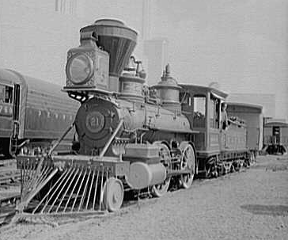 World’s Fair, railroad pageant. J. W. Bowker
World’s Fair, railroad pageant. J. W. BowkerLibrary of Congress, Prints and Photographs
Online Catalog
Additional details about John William Bowker’s discharge from the V. & T. Railroad are revealed in excerpts of two letters from H. M. Yerington to D. O. Mills (transcripts available at the Virginia and Truckee website):
Yerington was apparently wrong at least about Bowker’s patent on the locomotive smokestack. The Sacramento Daily Union, on 26 October 1869, reported the issue of a patent on 19 October described as a “Spark Arrester—John W. Bowker, Sacramento.” The invention was reportedly highly effective at suppressing sparks emanating from locomotive smoke stacks.
John William Bowker is listed in at least five editions (1866, 1867, 1871, 1876, and 1877) of the Great Registers of California as living in Township No. 9, Placer County, California (where Rocklin is located today), a few miles northeast of Sacramento. Those registers all show his age and place of birth as 52 years and Massachusetts. It’s possible that only the first register is accurate; based on that assumption, his birth year would be around 1814.


Two additional newspaper articles are believed to refer the same John William Bowker. The first appears in the Sacramento Daily Union on 7 March 1874, announcing the marriage of J. W. Bowker to Mrs. S. R. Dryden on 1 March in Carson, Nevada. The second article appears in the Daily Alta California, San Francisco, on 8 August 1877, announcing that a divorce was granted to Sarah R. Bowker from John W. Bowker in the Twelfth District Court (i.e., San Francisco).
Could this Mrs. Sarah R. Dryden possibly be the same Sarah R. mentioned in Sarah D. Shepherd’s will as married to William Bowker and living in San Francisco in 1876? If so (and it appears likely, based on this collection of circumstantial evidence), then Sarah R. must have first married a man named Dryden (who has not been identified), and then married her sister Mary’s first husband.
The ultimate fates of Sarah R. Shepherd-Dryden-Bowker and James William Bowker have not been determined.
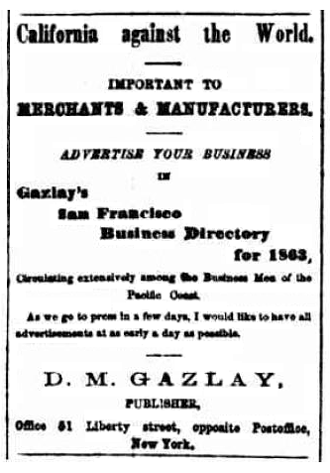
In the early 1860s, David established his California publishing business, listed as Gazlay, David M., book and job printer, 513 Clay [Street], dwl 1024 Stockton [Street] in Langley’s San Francisco Directory for the year commencing September 1861. The same directory lists Kasson C. S., solicitor, with D. M. Gazlay, and at least one employee is also listed: Daly Peter, printer with D. M. Gazlay. Directories for the years commencing September 1862 and October 1863 only list David’s dwelling, at 51 Government House, and 48 Belden Block, respectively.
David solicited for business advertisements in advance of publishing his San Francisco Business Directory for 1863 from as far away as New York. One such solicitation, appearing in the New York Evening Post on 15 January 1863, shows that he maintained a publishing office in New York City, at 51 Liberty Street.
Exactly when David returned to New York is not known, but if he traveled with his then-wife Mary, they must have traveled before she died in February 1864. David’s name doesn’t appear in San Francisco directories after 1863, so they probably traveled back to New York in late 1863.

While in New York, David published, as previously mentioned, his Gazlay’s Business Directory of the Five Great Cities of California and Oregon 1864, 1865, and the seven issues of Gazlay’s Pacific Monthly (January to July 1865). With his continuing interest in California, and likely to gather additional material for his Pacific Monthly, David traveled back to California, as stated in an article on 24 March 1865 in the New York Evening Express. Note the article two above his, announcing that President and Mrs. Lincoln planned to visit New York City on 1 May 1865. They never made the trip; Lincoln was shot and mortally wounded on 14 April and died the next day, only 21 days after the article was published.

New York State tax records for May, 1865, show that David owed taxes on both his personal income and on the business of David M. Gazlay & Co. Perhaps he was unable to pay his taxes, since he proceeded to liquidate his business, as stated in an article published in the New York Herald on 3 August 1865.
In 1868, David was living in Brooklyn and in the book business, located at 59 Cedar Street, New York City, according to Trow’s New York City Directory for 1868. Another directory, Lain’s Brooklyn City Directory for the year ending 1 May 1868, also lists David working at 59 Cedar, N.Y., but as a publisher, and living at 402 1/2 Cumberland in Brooklyn. The same directory lists a Charles Gazlay, carpenter, living at 304 Fulton. This is believed to be David’s father. Two other Gazlays are listed in the same directory: Harriet L. (widow) and Spencer M. (clerk), both living at 208 N. 1st. Harriet was married to Albert S. Gazlay, who is a brother of Charles, so Harriet is David’s aunt by marriage. Despite Harriet being listed in this directory as a widow, her husband Albert S. Gazlay was still living; he died in 1886. Spencer is Charles and Harriet’s son, so Spencer is David’s first cousin.
Mr. O’Reardon testified that he was performing at Tammany, New York, and received a letter with the name of the defendant attached, in which he was solicited to make an agreement to perform with the entertainment. Having answered affirmatively, a contract was forwarded him, signed by Gazley, to which he affixed his signature. At the time it was represented that the show would exhibit in the States, Canada, Central and South America. The agreement, however, was drawn up for an engagement of eight weeks, at a salary of $75 per week and hotel and other expenses. The paper was signed by both parties in the presence of S. W. Fort and William Carleton.
In Pursuance of the contract O’Reardon came to this city, and commenced fulfilling his engagement. Shortly after his arrival, he represented to Gazley that he wanted
Together with Mr. Carleton, the witness went to a photographic gallery, and had a number of pictures taken which Gazley agreed to pay for. On receiving the pictures, he handed the photographer a check for $17 dollars on the First National Bank, which had been given them, as witness alleges, by Gazley. The check, it seems, was presented to the bank, but was not paid, the allegation being that there was no money in the institution at the time to the credit of the names appended. There being no other witnesses present, the case was postponed until Saturday next, at ten o’clock.
A great number of persons who had been connected with the Entertainment, were present at the hearing, which appeared to possess much interest.
David is listed in the 1870 US Census, living in Philadelphia, aged 30 years, which is low by five years compared with the birth year, 1835, on his gravestone. Listed with him are: Mary, 20; Carrie, one; and Monte, five.
The Philadelphia City Directory for 1872 lists David as a publisher, living in Philadelphia. The same directory lists Charles M. Gazlay—David’s father, as we have previously surmised—but working and living at different Philadelphia addresses from David.
Although David and his family lived in Philadelphia at the time, David was dealing with forgery and fraud charges in New York, as indicated in an article in The Evening Post on 21 June 1872 (left). Once again, the outcome of these difficulties is not known, but there were more to come.
Back in Philadelphia, on 2 May 1873, David’s son, David Montross Gazlay, Jr., died suddenly. A death notice in the New York Herald the following day indicated that he was seven years and seven months old. His City of Philadelphia death certificate indicates that he was born in Brooklyn, and names his father, David M. Gazlay, and his mother, May M. Gazlay. He was buried in Philadelphia, although the death certificate doesn’t name the cemetery.
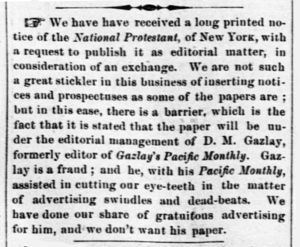
Whether true or not, David had gained a reputation in some circles for fraudulent business dealings, specifically, alleged advertising swindles associated with his Pacific Monthly, as seen in an article in The Kansas Chief, Troy, Kansas, on 18 November 1875 (right). A similar article from same paper appeared on 16 June 1881 (below).

Through the second half of the 1870s and into the 1880s, David lived and worked in various places in New York City and Brooklyn:
| Year Ending | Worked | Lived | Reference |
|---|---|---|---|
| 1 May 1876 | 67 Liberty (books) | Trow’s NYC Directory 1876 | |
| 1 May 1877 | 8 Park Pl (publisher) | 110 E. 10th St. | Trow’s NYC Directory 1877 |
| 1878 | 8 Park Place (publisher) | 110 E. 10th St. | NYC Directory 1878 |
| March 1878 | 34 Murray (treas, Rand Pub. Co.) | Wilson’s NYC Copartnership Directory 1879 | |
| 1 May 1879 | 14 Barclay (treas.) | 836 Dean, Brooklyn | Trow’s NYC Directory 1879 |
| 1 May 1880 | 34 Murray (sec.) | 60 W. 10th St. | Trow’s NYC Directory 1880 |
| 1 May 1881 | 30 Vesey (beer) | 60 W. 10th St. | Trow’s NYC Directory 1881 |
| 1 May 1882 | 22 Park Row (manager) | Brooklyn | Trow’s NYC Directory 1882 |
| 1 May 1885 | 32 Liberty | 256 Carroll, Brooklyn | Trow’s NYC Directory 1884 |
| 1 May 1886 | 188 Pacific | Lain’s Brooklyn Directory 1886 |

David was in the publishing business in partnership with Walter Heugh until they closed the business in 1877.
Also in 1877, The Real Estate Record and Builders’ Guide (Brooklyn, N.Y.: C.W. Sweet & Co., 7 July - 29 December 1877) lists, under Mortgages-Chattels, New York City, September 6-12, an entry in the category of Household Furniture, “Gazlay, D. W. [sic] 120 Nassau st...C. M. Gazlay. $400.” Despite the middle initial ’W,’ this appears to be David and probably his father, Charles M. Gazlay. David is listed here as the mortgagor, and C. M. Gazlay is the lender.
The 14 August 1879 edition of the New York Evening Express lists a judgment entered the previous day against David M. Gazley [sic] for Charles E. Haven (Kings county), $70.54. The reason for the judgment is not explained, but this was apparently a difficult time for David financially.
It appears that David’s fortunes improved in 1880. On 16 April, the New York Evening Press (left and center) announced the grand opening the next day of The Press Room, a restaurant and lager beer vault, M. M. Gazlay & Co., Proprietors. What a clever allusion to David’s publishing profession! The proprietor must be David’s wife Mary M. Gazlay. They both appear in Trow’s New York City Directory for the year ending 1 May 1881: Gazlay, David M., beer, 30 Vesey, h 60W. 10th; and Gazlay M. M., eating, 30 Vesey, h 836 Dean, B’klyn. It is unknown why they were working at the same address but living in different places. Another advertisement for The Press Room (right) appeared in the New York Evening Press on 30 April 1880, listing David M. Gazlay as manager.
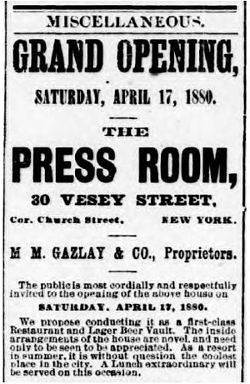
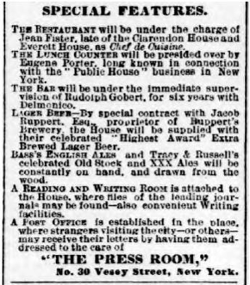
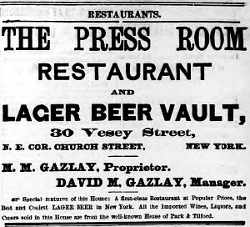
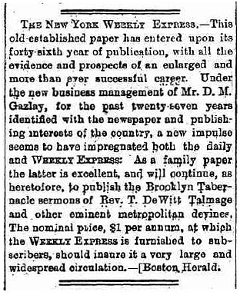
A year later, David took over the management of the New York Weekly Express newspaper. The 9 July 1881 article in The Corrector, Sag Harbor, Long Island, N.Y., (right) provides a positive endorsement of his long association with the newspaper and publishing interests of the country.

Shortly after, David’s wife and daughter were involved in an accident as passengers on a stagecoach ride. His wife’s hand was badly injured, according to an article in the New York Evening Express on 8 August 1881 (right).
Three editions of The Real Estate Record and Builders’ Guide shows that D. M. Gazlay sold properties in 1882—two in New York City (10 and 25 May), and one in Brooklyn (11 July).

Presumed to be David’s wife, a Mary Gazley [sic] was sent to a hospital after having been pronounced insane, as stated in a 25 August 1882 article in The Daily Graphic, New York, New York (right). It is not known how long she spent in the hospital.
The Philadelphia City Directory of 1888 lists Gazlay, David M., publisher, 153 N. 4th [Street]. This is the last reference to David being located in Philadelphia.
An article on 6 May 1890 in the Democratic Herald, Clyde, New York (and other newspapers) introduces “George Edgar Montgomery—widely known as a practical newspaper man—connected for many years with the New York Herald, New York Times,” and several other newspapers and journals, having just assumed the chief editorship of the New York Saturday Evening Gazette. The article also says that “The manager of the Gazette will be Mr. D. M. Gazlay, formerly of the old Evening Express.”
The Inland Printer (Volume VII, October 1889 to September 1890, Chicago: The Inland Printer Company.) provides the rest of the story regarding the New York Saturday Evening Gazette:
[In a separate article:]
The Saturday Evening Gazette Company is in trouble. The company was incorporated early in the year by David M. Gazlay. It was capitalized at $50,000. After the first number of the paper had been issued, Mr. Gazlay surrendered his stock and retired. It was then determined to suspend publication until a new company could be organized. George Edgar Montgomery, the editor, said, “I am told that the entire indebtedness of the Gazette will be liquidated by the present company, and I sincerely hope and believe that it will.”The 1892 New York State Census, enumerated on 16 February 1892, lists David M. Gazlay, aged 56 years, retired, and Marey [sic] M. Gazlay, aged 34 years, living in Brooklyn, Kings County, New York. Although listed as retired, David continued his involvement in a few publishing ventures during the following year.
David’s last known publication, other than newspapers, is titled The Presidents of the United States. A souvenir of the Presidential election and of the Columbian Exposition of 1892. Published by D. M. Gazlay, New York, 1892, it is described as one sheet depicting the first 23 Presidents.
The New York Tribune, on 1 January 1893, announced one more newspaper venture for David:
In June 1893, The Real Estate Record and Builders’ Guide (V. 51, January 1 - June 24 1893. New York, F. W. Dodge Corp.) lists the sale of engravings on 3 June: “Gazlay, D. M. 11 Park Row, New York...W. H. Thurstans. Engravings.” The address is that of The Sentinel Publishing Co., and so may indicate that David was liquidating assets of the company.
Chatham, New York, is in Columbia County, immediately south of Nassau, Rensselaer County. The following article, appearing in the Chatham Courier on 13 March 1895, credits David M. Gazlay with a pivotal role in the history of California: providing the stimulus for California’s decision to align with the Union at the brink of the Civil War. Who else but David himself could have written this anonymous article? And why a Chatham, N.Y., newspaper for its publication? It seems likely that David would have relocated to Rensselaer County in retirement, and that Chatham was the closest newspaper to his location.
Unpublished Incidents and Events of
The Early days of the Rebellion in
San Francisco
On or about the 10th day of February there appeared in the evening papers of San Francisco the following anonymous advertisement causing no little comment and doubt as to its origin and author.
At this critical moment sitting in a chair near the outside railing of the dais could be observed a young man resting very uneasy, and evidently under great suppressed mental anxiety. He was recognized as David M. Gazlay, engaged in the Book and Job printing business in that city—an active democrat, a member of the Democratic county committee and an enthusiastic unionist. At last the painful monotony of the meeting was broken by his rising to his feet and expressing his regret that an older and more experienced person had not moved in the matter, for it was he, heretofore unknown, who had anonymously called the meeting, and in a forcible and appropriate address announced the object and purpose of the meeting and moved that John H. Middleton, president of the Board of Supervisors then present take the chair, which was adopted and soon after Mr. Middleton was installed as chairman of the meeting. Young Gazlay again arose and moved that a committee of thirteen be appointed by the chair as an executive committee and committee of arrangements which also was adopted. The chairman named the committee and appointed Mr. Gazlay chairman. The child was born. From that moment the patriotism, manhood and independence of the unionists were aroused from its slumbering lethargy and asserted itself. Long before the appointed day of the meeting, it had reached fever beat, the secessionists were cowered. The Pacific
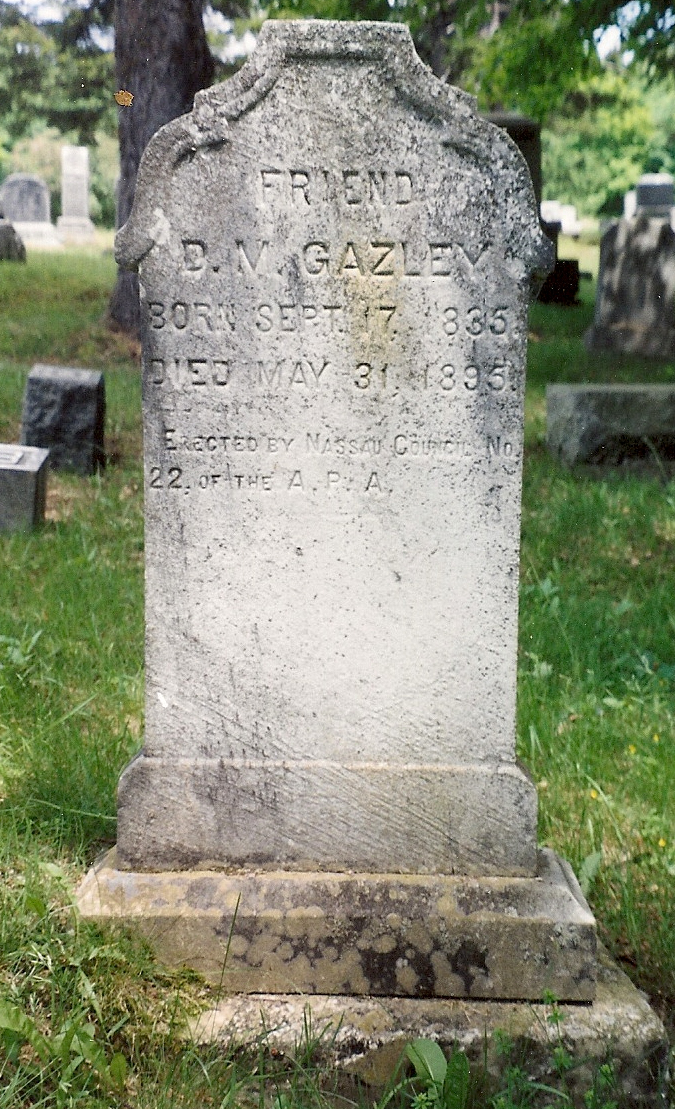
David died just two and a half months after the article was published. His gravestone in Hillside Cemetery, Stephentown, Rensselaer County, New York, reads:
D. M. GAZLEY
BORN SEPT. 17, 1835
DIED MAY 31, 1895
22 of the A. P. A.
What is the A. P. A.? The American Protective Association was a patriotic organization founded in 1887 by H. F. Bowers, attorney, in Clinton, Iowa. Any American citizen was eligible to join the A. P. A. According to The Cyclopædia of Fraternities, compiled and edited by Albert Clark Stevens (New York City: Paterson, N.J.: Hamilton Printing and Publishing Company, 1899), the main objective of the A. P. A. was the perpetual separation of church and state, i.e., to keep religion and politics apart. This essentially meant counteracting the alleged efforts of representatives in the United States of the papal government in Rome to dominate politics here with “the spirit of ecclesiastism” looking to the “union of church and state.” The Association’s total active membership in 1896 was probably more than 2,000,000.
It would seem that David must have been a member of the A. P. A. to have them erect his gravestone and to regard him as a ‘friend.’ While no records have been found that identify Nassau Council No. 22 of the A. P. A., it was likely in Nassau, Rensselaer County, New York. Knowing of David’s strong pro-Union sentiments while in California, it’s not surprising that he would support an organization like the A. P. A.
David’s sister, Mary Cornelia Gazlay, married Zial R. Avery on 19 January 1860 in New Berlin, Chenango County, New York, the same town where David and Mary lived at the time of the 1850 census. Zial worked as a keeper at Sing Sing Prison in Ossining, New York, for a few years, the same town where he and Mary Cornelia lived in 1870. Later they lived in New York City, where Zial worked on the New York elevated railroad. On 13 January 1889, Zial was tragically struck and killed by a locomotive while walking home across the tracks. The following year, Mary erected a very pretty bronze monument in Reynolds Cemetery, Cross River, Westchester County, New York, in memory of her late husband.
It is believed that, a few years later, Mary Cornelia married John H. Flower. John H. and Cornelia Flower are found in the 1892 New York State Census, living in Brooklyn, Kings County, New York. Mary was living with her mother, Martha Coon (or Coons), in Nassau Town, Rensselaer County, as listed in the 1900 US Federal Census. For unknown reasons, Mary’s husband John Flower is not shown with them in that census record. John died on 7 February 1901 in Brooklyn, as listed in New York death records and a brief death notice in the Brooklyn Daily Eagle. In the 1905 New York State Census, Martha A. Coon and daughter Mary Cornelia Flower (erroneously listed as Flower C. Coon), were still living in Nassau, in the household of a family of Coon relatives, Martha’s in-laws.
Mary Cornelia Flower died on 3 January 1907, according to Rensselaer County Probate Records (Vol. 227, Pg. 77). She had no children. A series of articles in various newspapers carried the story of her contested will. One of the early articles appeared in The Albany Evening Journal on 1 May 1907 (right). The case was eventually resolved in favor of Carrie Hamilton and Martha Coons. Significant in this series of probate articles is that they state the relationship between Mary Cornelia, Martha, and Carrie.
Rensselaer County Probate Records (Vol. 240, Pg. 68) indicate that Martha Coons died on 23 July 1909. Surrogate Court index records indicates she was a widow with one granddaughter, which, of course, is Carrie A. (Gazlay) Hamilton.

David Montross Gazlay led a fascinating life—publisher, printer, restaurateur, patriot, husband, father—and died at the early age of 59 years. He left a legacy of innovation in advertising in city directories. David published several noteworthy directories, periodicals, and other publications, and he played a key role in California’s decision to align with the Union on the brink of the Civil War. David left only one natural descendant who lived to adulthood, a daughter, and no natural grandchildren; his two adopted daughters both grew to adulthood and had descendants, some to present day.